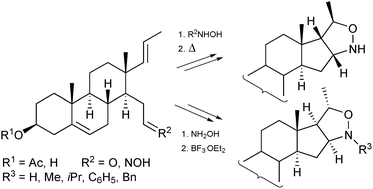Intramolecular approach to some new D-ring-fused steroidal isoxazolidines by 1,3-dipolar cycloaddition: synthesis, theoretical and in vitro pharmacological studies
Abstract
Intramolecular

Maintenance work is planned for Wednesday 1st May 2024 from 9:00am to 11:00am (BST).
During this time, the performance of our website may be affected - searches may run slowly and some pages may be temporarily unavailable. If this happens, please try refreshing your web browser or try waiting two to three minutes before trying again.
We apologise for any inconvenience this might cause and thank you for your patience.
* Corresponding authors
a
Department of Organic Chemistry, University of Szeged, Dóm tér 8, H-6720 Szeged, Hungary
E-mail:
frank@chem.u-szeged.hu
Fax: +36-62-544199
Tel: +36-62-544275
b
Department of Chemistry and Chemical Informatics, Faculty of Education, University of Szeged, Boldogasszony sgt. 6, H-6725 Szeged, Hungary
E-mail:
zoltanmucsi@gmail.com
c
1st Department of Medicine, University of Szeged, Korányi fasor 8-10, H-6720 Szeged, Hungary
E-mail:
szecsim@endoc.szote.u-szeged.hu
d
Department of Pharmacodynamics and Biopharmacy, University of Szeged, Eötvös u. 6, H-6720 Szeged, Hungary
E-mail:
zupko@pharm.u-szeged.hu
Intramolecular

 Please wait while we load your content...
Something went wrong. Try again?
Please wait while we load your content...
Something went wrong. Try again?
É. Frank, Z. Mucsi, M. Szécsi, I. Zupkó, J. Wölfling and G. Schneider, New J. Chem., 2010, 34, 2671 DOI: 10.1039/C0NJ00150C
To request permission to reproduce material from this article, please go to the Copyright Clearance Center request page.
If you are an author contributing to an RSC publication, you do not need to request permission provided correct acknowledgement is given.
If you are the author of this article, you do not need to request permission to reproduce figures and diagrams provided correct acknowledgement is given. If you want to reproduce the whole article in a third-party publication (excluding your thesis/dissertation for which permission is not required) please go to the Copyright Clearance Center request page.
Read more about how to correctly acknowledge RSC content.
 Fetching data from CrossRef.
Fetching data from CrossRef.
This may take some time to load.
Loading related content
